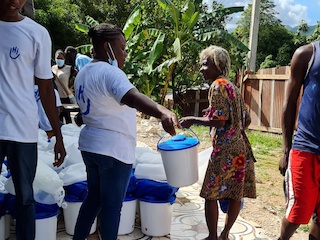Climate change is a global issue - one that contributes to humanitarian need worldwide. However, the operations and processes involved in humanitarian action have their own environmental impacts. In order to respect our commitment to “Do No Harm,” NGO’s must take appropriate steps to reduce their carbon footprints as much as possible.
In December 2020, Humanity & Inclusion (HI) signed a commitment alongside 9 other humanitarian organisations to integrate climate change accounting into its operations.
Through the agreement,[1] HI commits formally to:
- Measuring the environmental and carbon impacts of its actions
- Reducing its carbon footprint
- Adapting its humanitarian action to meet climate-related challenges
- Communicating progress made and actions taken
- Encouraging other actors to do the same
In 2021, to implement their commitment, the same 10 humanitarian organisations officially established a consortium, known as C.H.A.N.G.E (Consortium of Humanitarian Actors and Networks Engaged in Greenhouse gas Emissions reduction). Through CHANGE, HI and its fellow actors aim to determine the current carbon footprint of their individual activities, and ultimately reduce the impact of humanitarian action on climate change.
Developing common standards
Presently, there is no requirement for humanitarian organisations to measure their carbon footprints. For those that choose to do so out of their own initiative, there is no uniform system, meaning that each organisation measures differently- producing confusing, inconsistent reporting across the sector.
 “Currently everyone is using different parameters and ways of counting,” says Denis Bedjai, HI Logistics Advisor and Environmental Agenda Project Manager. “But it doesn’t make sense to compare different kinds of measurements. We want to create one method that is common to all NGOs.”
“Currently everyone is using different parameters and ways of counting,” says Denis Bedjai, HI Logistics Advisor and Environmental Agenda Project Manager. “But it doesn’t make sense to compare different kinds of measurements. We want to create one method that is common to all NGOs.”
HI and its fellow CHANGE members are working together to determine common accounting parameters for their greenhouse gas emissions, with support from Citepa, an organisation with over 60 years of experience in air, climate and energy. Getting a clearer idea of their impact will enable the organisations to develop reduction plans for the future.
What makes up the carbon footprint?
There are numerous parameters to account for when measuring greenhouse gas emissions. Most organisations measure emissions that come from lighting and heating the office, or from driving organisation vehicles, but many indirect emissions go unaccounted for. Any energy purchased through external providers, waste generated, transportation, distribution, production of goods, or even investments are just a few of the many factors that contribute to an organisation’s overall carbon footprint. In humanitarian contexts, the supply chain may comprise a large part of the greenhouse gas emissions, so accounting for each step is crucial.
“If we purchase buckets for hygiene kits, we need to know where that  bucket comes from, how it was made, how it was transported, how the waste was managed etc.,” Denis explains. “Even though we didn’t produce the bucket itself, we have to take into consideration its entire life cycle as part of our carbon footprint when we buy it.”
bucket comes from, how it was made, how it was transported, how the waste was managed etc.,” Denis explains. “Even though we didn’t produce the bucket itself, we have to take into consideration its entire life cycle as part of our carbon footprint when we buy it.”
Creating an emissions factors database
Once the standard of accounting parameters is set, the consortium members must conduct the actual measurements. However, measuring greenhouse gas emissions is even more difficult in low-resource or economically developing nations.
To simplify the process, the CHANGE consortium and its partners plan to continue the development of a database specific to the humanitarian sector. Initiated by the ICRC (International Committee of the Red Cross), the emissions factor database will be adapted to intervention locations, free to users, and will enable organisations to more accurately track the greenhouse gas emissions associated with their frequent actions or service providers.
Adopting action plans
Once HI has a clearer vision of its current carbon emissions, the organisation plans to set targets to reduce those emissions by implementing adapted action plans.
“For example, if we see that travel by plane is a major source of our greenhouse gas emissions during the auditing phase, we would determine steps to reduce that where possible. Only sending people when absolutely necessary, using the shortest flight routes, making sure to send groups together- these are all best practices for keeping those emissions as low as possible.” explains Denis.
In the long-term, HI aims not only to reduce its own carbon footprint, but to support local humanitarian actors in doing the same. By implementing projects that reinforce organisations’ skills and capacities to introduce conscious ecological measures, HI will be able to further its goal of lessening the ecological impact of humanitarian aid on local and international levels.
 GREEN Initiative: HI is committed to reducing the adverse effects of climate change on vulnerable and marginalised populations worldwide. We help communities prepare for and adapt to climate shocks and stresses, and we respond to crises magnified by environmental factors. Applying a disability, gender and age (DGA) inclusion lens across all our actions, we advocate for practitioners and policy-makers to embed DGA in their climate work as well. HI is also determined to reduce its own ecological footprint by adapting and implementing environmentally conscious approaches to humanitarian action.
GREEN Initiative: HI is committed to reducing the adverse effects of climate change on vulnerable and marginalised populations worldwide. We help communities prepare for and adapt to climate shocks and stresses, and we respond to crises magnified by environmental factors. Applying a disability, gender and age (DGA) inclusion lens across all our actions, we advocate for practitioners and policy-makers to embed DGA in their climate work as well. HI is also determined to reduce its own ecological footprint by adapting and implementing environmentally conscious approaches to humanitarian action.
[1] ‘Statement of Commitment on Climate by Humanitarian Organisations’ Issued by Group URD (Urgence, Rehabilitation, Developpement)


 “Currently everyone is using different parameters and ways of counting,” says Denis Bedjai, HI Logistics Advisor and Environmental Agenda Project Manager. “But it doesn’t make sense to compare different kinds of measurements. We want to create one method that is common to all NGOs.”
“Currently everyone is using different parameters and ways of counting,” says Denis Bedjai, HI Logistics Advisor and Environmental Agenda Project Manager. “But it doesn’t make sense to compare different kinds of measurements. We want to create one method that is common to all NGOs.” bucket comes from, how it was made, how it was transported, how the waste was managed etc.,” Denis explains. “Even though we didn’t produce the bucket itself, we have to take into consideration its entire life cycle as part of our carbon footprint when we buy it.”
bucket comes from, how it was made, how it was transported, how the waste was managed etc.,” Denis explains. “Even though we didn’t produce the bucket itself, we have to take into consideration its entire life cycle as part of our carbon footprint when we buy it.” GREEN Initiative:
GREEN Initiative:


